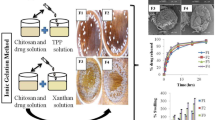Abstract
The objective of the present investigation was to prepare and evaluate a floating granular delivery system for the treatment of mucosal ulcer consisting of (i) calcium silicate (CS) as a porous carrier; (ii) ranitidine hydrochloride (RH), an anti-ulcer agent; and (iii) hydroxypropyl methylcellulose K4M (HPMC) and ethylcellulose (EC) as matrix-forming polymers. The effect of various formulation and process variables on the particle morphology, particle size, micromeritic properties, percent drug content, in vitro floating behavior, and in vitro drug release from the floating granules was studied. Scanning electron microscopy (SEM) of the granules revealed that that more pores of CS in secondary coated granules (SCG) were covered by the polymer solution than those in primary coated granules (PCG). The formulation demonstrated favorable in vitro floating and sustained drug release characteristics. The in vivo evaluation for the determination of pharmacokinetic parameters was performed in albino rats. Higher plasma concentration was maintained throughout the study period from the floating granules of RH. The enhanced bioavailability and elimination half-life observed in the present study may be due to the floating nature of the dosage form and the reduction of the absolute alcohol-induced ulcerogenic index from 3.0 to 0.6. The results suggested that CS is a useful carrier for the development of floating and sustained release preparations.




Similar content being viewed by others
References
Akiyama Y, Nagahara N (1999) Bioadhesive Drug Delivery Systems: Fundamentals, Novel Approaches and Development, Mathiowitz E, Chickering III, DE, Lehr CM, (ed.) Marcel Dekker, New York, 477–505
Bandelin FJ (1994) Pharmaceutical Dosage Forms: Tablets. In: Schwartz JB (ed.) Theory and practice of industrial pharmacy, 2nd ed., Vol. I, Varghese Publication House Bombay, Bombay, 131–193
Bolton S, Izevbehai PH, Desai S (1989) Floating sustained release therapeutic composition. US patent 814(4):178
Brogden RN, Carmine AA, Heel RC, Speight TM, Avery GS (1982) Ranitidine: a review of its pharmacology and therapeutic use in peptic ulcer disease and other allied diseases. Drugs 24:267–303
Curatolo WJ, Lo J (1995) Gastric retention system for controlled drug release. US patent 443(5):843
Gorden RE, Rosanske TW, Fonner DE, Anderson NR, Banker GS (1999) Pharmaceutical Dosage Forms: Tablets. In: Schwartz JB (ed.) Theory and practice of industrial pharmacy, 2nd ed., Vol. II, New York, Marcel Dekker, Inc, 245–316
Ichikawa M, Watanabe S, Miyake Y (1987) Granule remaining in stomach. European patent 0235718
Jain SK, Agrawal GP (2004) Floating flap: a sustained release polymeric device for the delivery of albendazole and closantel for veterinary use. Ind J Pharm Sci 66(1):63–68
Jain SK, Jain NK, Agrawal GP (2005) A novel calcium silicate based microspheres of repaglinide: in vivo investigations. J Control Rel 107:300–309
Joseph NJ, Lakshmi S, Jayakrishnan A (2002) A floating-type oral dosage form for piroxicam based on hollow polycarbonate microspheres: in vitro and in vivo evaluation in rabbits. J Control Rel 79:71–80
Kunchandy J, Khanna S, Kulkarni SK (1985) The anti secretory and ulcer protective activity of ocium centum. Arch Int Pharmacol 275:123–26
Li S, Lin S, Daggy BP, Mirchandani HL, Chien YW (2005) Effect of HPMC and carbopol on the release and floating properties of gastric floating drug delivery system using factorial design. Int J Pharm 253:13–22
Miyazaki S, Yamaguchi H, Yokouchi C., Takada M, Hou WM (1998) Sustained-release and intragastric-floating granules of indomethacin using chitosan in rabbits. Chem Pharm Bull 36:4033–4038
Moes A (1993) Floating delivery and other potential gastric retaining systems. Current status on targeted drug delivery to the gastrointestinal tract. J Capsugel Lib 97–112
Muller W, Anders E (1989) Floating system for oral therapy. World patent 89,06956
Nakamichi K, Izumi S, Yasura H (1996) Gastric remaining preparation, swollen molding and production process. European patent 0,717,988
Singh BM, Kim KH (2000) Floating drug delivery systems: an approach to oral controlled drug delivery via gastric retention. J Control Rel 63:235–259
Strubel J, Siepmann R, (2003) pH-independent release of a weakly basic drug from water-insoluble and -soluble matrix tablets. Eur J Pharm Sci 18:37–45
Streubel A, Siepmann J, Bodmeier R (2002) Floating microparticles based on low density foam powder. Int J Pharm 241:279–292
Whitehead L, Fell JT, Sharma HL, Smith AM (1998) Floating dosage forms: an in vivo study demonstrating prolonged gastric retention. J Control Rel 55:3–12
Wong PSL, Theeuwes F, Larsen SD (1993) Self-retaining gastrointestinal delivery device. US patent (5):198–229
Yuasa H, Takashima Y, Kanaya Y (1996) Studies on the development of intragastric floating and sustained release preparation. I. Application of calcium silicate as a floating carrier. Chem Pharm Bull 44:1361–1366
Acknowledgements
One of the authors, Ashish Jain, expresses his sincere thanks to the All India Council of Technical Education, New Delhi, India for awarding a Junior Research Fellowship during his M.Pharm. programme. The authors gratefully acknowledge M/s Cadila Pharmaceuticals, Ltd., Ahmedabad, India for the supply of ranitidine hydrochloride as a gift sample. The authors also wish to thank Dr. Rajesh Pathania of the All India Institute of Medical Sciences, New Delhi, India for providing facilities for the SEM study.
Author information
Authors and Affiliations
Corresponding author
Rights and permissions
About this article
Cite this article
Jain, A., Jain, P., Jain, S.K. et al. Calcium-silicate-based floating granular delivery system of ranitidine hydrochloride for effective management of peptic ulcer. Med Chem Res 17, 305–317 (2008). https://doi.org/10.1007/s00044-007-9066-z
Received:
Accepted:
Published:
Issue Date:
DOI: https://doi.org/10.1007/s00044-007-9066-z




